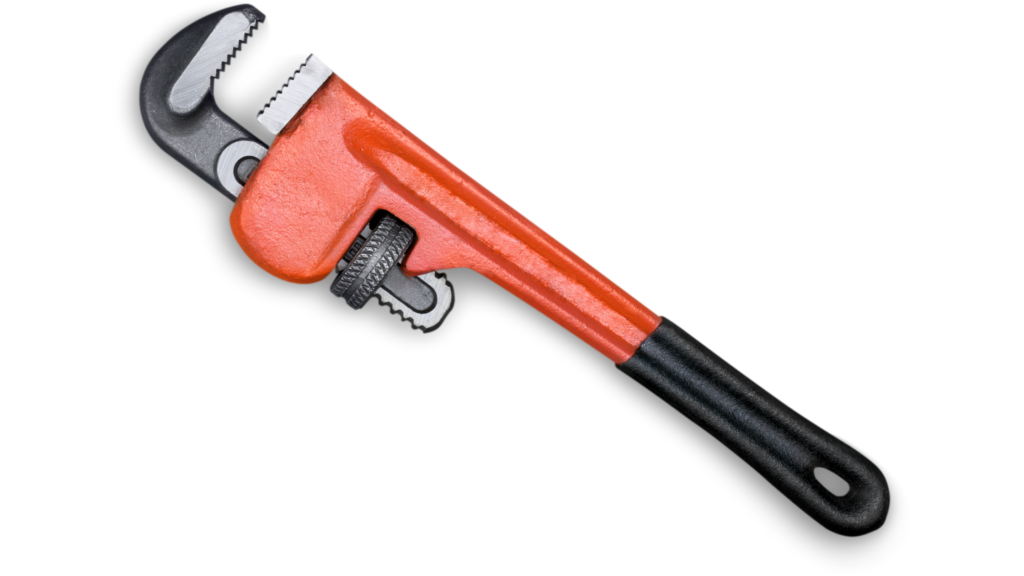A pipe wrench (also known as the Stillson wrench or monkey wrench) is a commonly used plumbing tool used often when working with pipes. It’s a versatile tool that is designed to grip and turn round surfaces such as pipes, fittings, and plugs.
In this blog post, we will explore the different types of pipe wrenches and their uses, and more. Whether you’re a professional plumber, a DIY enthusiast, or just looking to understand the different types of pipe wrenches, you’ll find valuable information in this post.
What is a pipe wrench?
Made of cast steel or aluminum, a pipe wrench is a tool that is used to grip rounded metal objects like pipes, bolts, or rods to tighten or loosen them. The pipe wrench comprises two serrated jaws, a hook jaw on the top, and a heel jaw piece at the bottom, which is connected to a handle.
The tiny grooves or teeth on the jaws grip the rounded objects. The lower jaw can be adjusted so that when the wrench is tightened it fits the metal objects tightly and provides a firmer grip that enables you to turn the pipe, even when there is resistance.
What does a pipe wrench look like?
This is what a pipe wrench looks like:

Parts of a pipe wrench
There are many different types of pipe wrenches in terms of types and sizes. The basic components of a pipe wrench include:
- Hook jaw
- Pin jaw
- Body
- Nut
- Pin
- Spring assembly
Types of pipe wrenches
Typically, pipe wrenches are classified on the basis of the length of their handles. They are available in various sizes—right from 3 inches up to 48 inches or bigger. Each size works on a specific range of pipe sizes. The different types of pipe wrenches include:
- End Pipe Wrench: These are meant to repair the bits of end pipes that lie close to the wall, in between tight openings or in narrow spaces. The end pipe wrench has teeth in the jaws that enable them to grip the pipe better, enabling easy movement.
- Offset Wrench: This is essentially a wrench with a box end i.e., a closed-end, which is suitable for pipes that are at awkward angles or located in tight spaces. The wrench slips over the bolt head vertically and accesses it from the vertical direction instead of from the sides.
- Strap Wrench: Meant to work on oddly shaped pipes, the strap wrench has a handle and strap made of leather, rubber, chain or metal, which is attached to the pipe and the wrench works due to the friction between the pipe and strap.
- Compound Leverage Wrench: This is mainly used for loosening frozen joints, bolts, etc. due to age, weather, build-up or damage by applying force.
- Straight Pipe Wrench: The straight pipe wrench is generally made of iron and has jaw hooks featuring self-cleaning threads. An extremely versatile tool, the straight pipe wrench is multi-functional and can be used for several applications and everyday problems.
How does a pipe wrench work?
Pipe wrenches are quite easy to use; however, you must ensure to wear good gloves when using the pipe wrench because when the jaws of the wrench dig into the pipe, it can leave sharp burrs, which can cut your hand. To use the pipe wrench:
- The wrench must be placed on the pipe in such a way that the mouth of the jaw faces the direction in which you want to turn the pipe.
- You must ensure that the pipe is centered properly in the jaws of the wrench.
- Then, turn the nut to adjust the jaw so that it fits the pipe tightly.
- Push or pull the pipe wrench in the direction that you want the pipe to turn.
What is a pipe wrench used for?
The most common use of a pipe wrench is for tightening and loosening fittings and connections on pipes, such as fittings on a water line.
Additionally, pipe wrenches are also commonly used for turning valves, such as gate valves and ball valves, which control the flow of water in a plumbing system.
Pipe wrenches are also used to install or remove different types of pipe fittings like elbows, tees, and couplings, and to remove or install pipe.